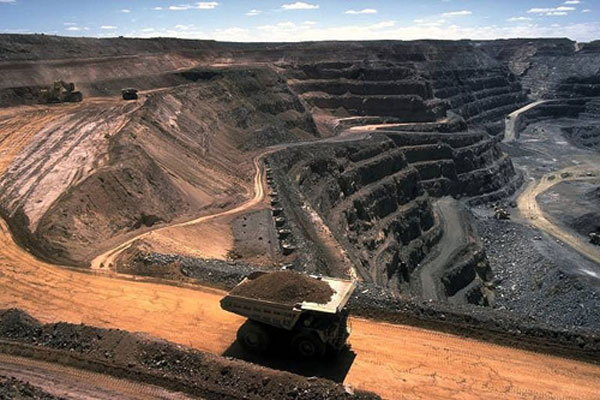It is hard to believe that the village of Sandur in Bellary district was once the epicentre of one of the biggest mining scams and environmental disasters that India has seen. The red soil is rich and fertile, say local farmers, and the lush green landscape, irrigated by borewells, is testimony to how well it has been doing in the last two years.
Yet, towering above these farms is a category-C mine on a majestic bluff, whose lease belongs to Anil Lad, a local politician. That mine is shut today, as are all in this category, but in its heydey, the blasts from its rock promontory resulted in blankets of dust perennially coating Sandur, stunting its crops and causing pulmonary problems amongst its residents. Today, the two-year ban on mining has produced remarkable results: The yield of onions in Sandur’s farms have risen from 8 tonnes to 18, while maize has improved from 15 quintals to 25, say farmers. Even the banana and tamarind trees, which were stunted and anaemic, have shot up and are flowering.
Sandur was not always a beehive of mining activity and in fact, the ’90s marked a period where extracting ore was barely profitable. Then, suddenly, in the early 2000s, things began to change at breathtaking speed as China’s ravenous appetite for ore made Sandur a city of gold for a select few.
These were politicians and businessmen in Karnataka, entwined in an unholy alliance to rip-off the state, says the state’s Lok Ayukta Final Report that came out in July 2011. The report describes protection and extortion rackets masterminded by G Janardhana Reddy as well as illegal money transfers and tax shelters architected by mining entities such as Associated Mining Company and Obulapuram Mining Company, owned by the Reddy brothers. How lucrative was this scam? Mine owners would pay $33 (Rs 1,790) per tonne for ore production and another $13 (Rs 705) in logistics costs. Their revenues? $225 (Rs 12,206), leaving them with a profit of $180 (Rs 9,765) per tonne on average.
According to reports, mining here involved the massive encroachment of forestland, which resulted in an ecological disaster due in addition to massive underpayment of state mining royalties. Officials at road check-posts colluded in all of this by large-scale under-counting and under-invoicing of lorries transporting iron-ore to the ports which was then exported illegally. Thanks to the Lok Aayukta report “the Republic of Bellary collapsed like a house of cards,” says Vishnu Kamath, a chemistry professor at Bangalore University and a chairman of the study team of the National Committee for Protection of Natural Resources. “The climate of fear has gone now that they’ve been sent to jail like common criminals,” he adds.
If you wend your way through the hillocks of Sandur today, you are confronted by a ghost town, populated by empty mines with hundred of stranded earth-moving machines that look like hapless iron dinosaurs from a distant age of machines. A railway line belonging to JSW steel snakes its way among stockades built by companies to store ore before their eventual transportation. Most striking is the condition of the hamlets that are wedged in between these stockades-still dirt-poor, with little running water, electricity or any kind of amenity that could indicate their position amidst one of the richest resource-booms in Indian history. “It is better that these mines are nationalised – at least then you can fight against the government,” says Sivakumar, a lawyer for Citizens’ Welfare Association, who has filed numerous cases against mine owners.
Crooked politicians are one thing, but what enrages Kamath is the role that corporates like JSW Steel-which owns India’s largest steel plant, built in 1997, situated 25 km away from Sandur-have played. “JSW Steel benefitted enormously from illegal mining activity over the last decade from the consumption of illegal ore,” says Kamath. “The trip-sheets of individual lorry loads should be 10-12 tonnes-but mid-2012, waybill details show the loads that were being received were at least 36 tonnes, with no account of the source of the ore. This is not the standard of business expected in a global company,” he adds. Additionally, the Central Bureau of Investigation (CBI) says its probe found that the company and its subsidiary, South West Mining, gave a Rs 20-crore bribe to an education trust run by the kin of former chief minister B S Yeddyurappa, as a ‘quid pro quo’ for not insisting on recovery of Rs 890 crore from Vijayanagar Minerals, a joint venture between JSW and state-run Mysore Minerals Ltd (MML).
A JSW spokesperson dismisses Kamath’s allegations, as well as the CBI chargesheet, as being completely baseless. “If we had to bribe someone, why would we give them a cheque?” he asks. The overloading was done by people exporting ore who stood to gain directly from this, he adds. When asked as to how JSW has contributed to Sandur, he says that a free tailoring institute handed out 2,000 sewing machines and 238 toilets were also dug there. Plus, the steel factory has given jobs to 33,000 people in the region he adds, 80 per cent of whom are Kannadigas.
On April 18, 2013, the Supreme Court permitted mining in Category-A and B but cancelled 49 leases in Category-C mines, where maximum illegalities were reported. Kamath says that the order-with its long list of procedural checks-is pushing the system in the right direction, “but is not transformational.” He adds that a good capitalist system will have a tough regulatory environment “but here I don’t see so much change in the quality of governance. After all, the barons all got tickets this time around and the spineless bureaucracy is still the same,” he adds.
If monitoring mechanisms that the Supreme Court has asked for continue to be ignored, and have little participation from Sandur’s citizens, the area is bound to see more wretchedness dispensed by the very people it votes into power.

